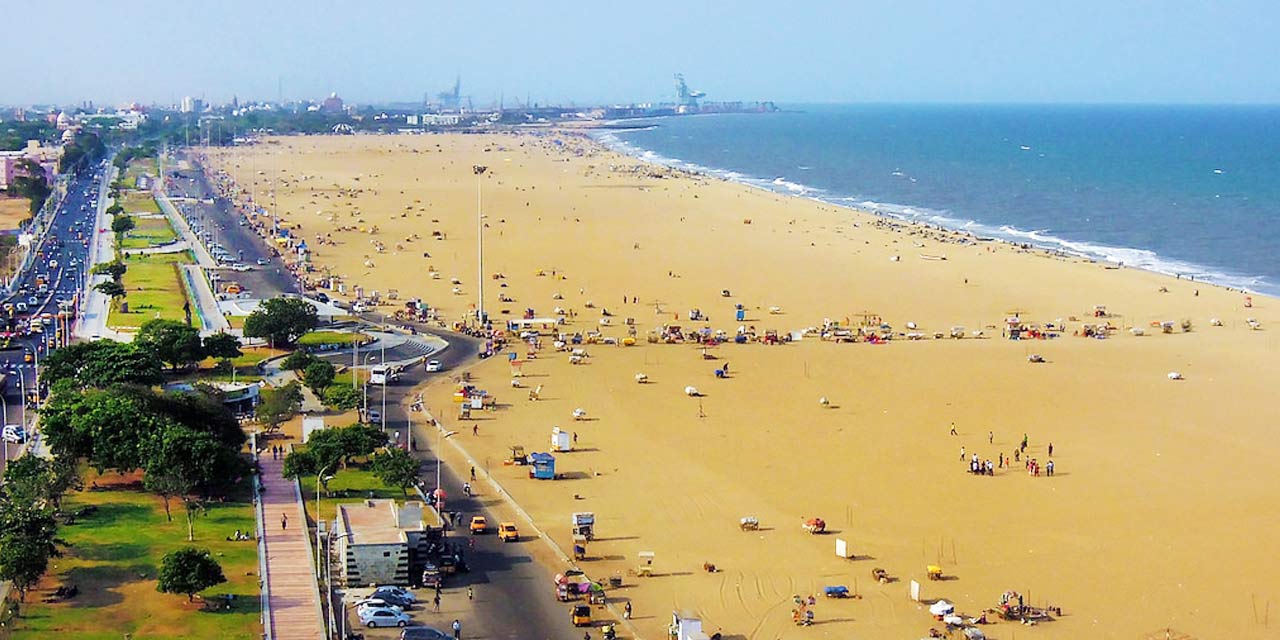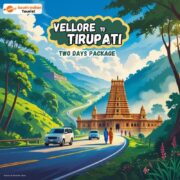
Top 5 Chennai Tourist Places You Must Visit
1. Marina Beach, often simply called “The Marina,” is a standout among Chennai tourist places. Located in Chennai, Tamil Nadu, this natural urban beach stretches along the Bay of Bengal, making it one of the most iconic landmarks in the city. Whether you’re a local or a visitor, Marina Beach offers a vibrant and scenic experience that shouldn’t be missed.
Overview of Marina Beach
Location: Chennai, Tamil Nadu, India
Coast: Coromandel Coast, Bay of Bengal
Type: Urban, natural sandy beach
Total Length: 13 km (8.1 mi)
Length of Promenade: 6 km (3.7 mi)
Maximum Width: 437 m (1,434 ft)
Orientation: North-South
Notable Landmarks: Lighthouse, Anna Memorial, M.G.R. and Amma Memorial, Napier Bridge
Governing Authority: Corporation of Chennai
Attractions at Marina Beach
- Chennai Lighthouse: Enjoy panoramic views of the beach and cityscape from this iconic lighthouse.
- Anna Memorial: A tribute to former Chief Minister C.N. Annadurai, this memorial is an important landmark.
- M.G.R. and Amma Memorials: Pay homage at the memorials dedicated to the legendary leaders M.G. Ramachandran and J. Jayalalithaa.
- Napier Bridge:This historical bridge connects different parts of the beach and is known for its distinct architecture.
Visiting Marina Beach
Bathing and Swimming: Please note that bathing and swimming are legally prohibited at Marina Beach due to strong undercurrents and safety concerns.
Crowds: Marina Beach is one of the most crowded beaches in India, attracting around 30,000 visitors daily on weekdays and up to 50,000 on weekends and holidays. During the summer months, daily visitors can reach 15,000 to 20,000.
How to Reach Marina Beach
By Train:
- Chepauk Railway Station: It is about a 3-minute train ride from Chennai Central. It’s just a short walk away from Marina Beach
- Thiruvallikeni Railway Station: Also around 3 to 10 minutes from Chennai Central by local train.
- Lighthouse Railway Station: A convenient option close to the Marina area.
By Bus:
- Local Buses: Several city buses travel to Marina Beach, with routes connecting to major parts of the city.
By Car/Taxi:
- Driving: Marina Beach is easily accessible by car or taxi. There are parking facilities along the beach road.
By Auto-Rickshaw:
- Convenient Rides: Auto-rickshaws are a popular and flexible option for reaching Marina Beach from various parts of Chennai.
Tips for Visitors
- Timing: Visit Marina Beach early in the morning or late in the evening to avoid peak crowds and enjoy a more peaceful experience.
- Safety Tips: Stick to the designated areas and avoid swimming in the sea. Enjoy the beach from the shore and take in the nearby attractions.
Marina Beach offers a vibrant mix of natural beauty, cultural landmarks, and bustling activity, making it a must-see among Chennai tourist places. With its picturesque setting and rich history, Marina Beach promises a memorable experience for all who visit.
2. Fort St. George: A Historical Gem Among Chennai Tourist Places
Fort St. George, often referred to as White Town in historical contexts, is a prominent landmark situated in Chennai, India. Established in 1639, this fortress was the first English, and later British, fortification in India. It played a crucial role in the early development of Chennai, previously known as Madras.
Historical Significance of Fort St. George
Fort St. George was founded by the British East India Company in 1639 on a stretch of uninhabited land along the Bay of Bengal. The fort’s construction marked the beginning of British influence in the region, facilitating further settlements and trade activities. Over time, Chennai developed around the fort, which became a central hub of colonial administration and commerce.
What to See at Fort St. George
Fort St. George, one of Chennai’s most historic landmarks, offers a range of attractions that highlight its rich colonial past and architectural significance. Here are the must-see highlights during your visit:
- St. Mary’s Church
- Description: This historic church is one of the oldest Protestant churches in India, known for its beautiful colonial-era architecture and serene atmosphere.
- Highlight: The church’s interior features exquisite old-world charm with its antique pews and memorial plaques.
- Fort Museum
- Description: Located within the fort, this museum provides a fascinating glimpse into the British colonial era with its diverse collection of artifacts.
- Highlight: The museum features military uniforms, weapons, and historical documents that illustrate the fort’s significance and British influence in India.
- Tamil Nadu Legislative Assembly
- Description: The fort houses the Tamil Nadu legislative assembly, continuing its role in regional governance.
- Highlight: While access may be restricted, the building’s historical significance as a center of administration is noteworthy.
- Colonial Architecture
- Description:Fort St. George exemplifies 18th-century military design. Its layout and construction highlight the strategic and architectural approaches of that era.
- Highlight: The well-preserved walls and bastions provide insight into historical defensive strategies.
- Historical Significance
- Description: Founded in 1639, Fort St. George marks the beginning of British influence in India and the city’s growth.
- Highlight: The fort’s role in Chennai’s development makes it a key historical site, offering a deeper understanding of the city’s evolution.
Visiting Tips
- Opening Hours: The fort is generally open from 9:30 AM to 5:00 PM. Verify the opening hours and any potential closures before you plan your visit.
- Entry Fee: There is typically a nominal fee for the Fort Museum. Check the latest entry fees before your visit.
- Dress Code: Dress modestly as the fort includes places of worship and government buildings.
- Photography: Be aware of any restrictions on photography within certain areas of the fort.
Fort St. George stands as a significant site among Chennai’s tourist attractions, offering a blend of historical insight and architectural beauty. Don’t miss the chance to explore these key elements and experience the rich legacy of this iconic landmark.
3. Guindy National Park: A Green Oasis in Chennai
Guindy National Park is a unique and treasured green space located in the heart of Chennai, India. Covering an area of 2.70 square kilometers (1.04 square miles), it stands out as one of the smallest national parks in India. Despite its compact size, it offers a rich and diverse natural experience, making it a valuable sanctuary amidst the bustling city.
What Makes Guindy National Park Special?
Guindy National Park in Chennai offers a rare blend of natural beauty and urban surroundings. Here’s what makes it special:
- Diverse Wildlife: The park is home to over 350 types of plants, more than 150 bird species, and 14 different mammals. It also hosts around 60 species of butterflies and spiders, along with various reptiles and amphibians.
- Urban Retreat: Located right in the city, Guindy National Park provides a refreshing escape from urban hustle. It’s a rare green oasis where people can enjoy nature close to home.
- Educational and Fun: The park is perfect for learning about wildlife and nature. It offers opportunities for nature walks, bird watching, and exploring different animal species.
Guindy National Park is a special place in Chennai, combining rich natural life with a convenient location. It’s a great spot for anyone looking to connect with nature without leaving the city.
Entry Fees and Visiting Hours
Guindy National Park and Snake Park offer the following entry fees and visiting hours:
- Children (Under 5 Years): ₹15
- Children (5 to 12 Years): ₹15
- Adults: ₹20
Visiting Hours: The National Park and Snake Park are open daily from 9:00 AM to 5:30 PM.
Experience the beauty and wildlife of these parks at affordable rates during convenient hours.
4. Mahabalipuram
The Group of Monuments at Mahabalipuram is a UNESCO World Heritage Site located in Mahabalipuram, Tamil Nadu, India, about 60 kilometers (37 miles) south of Chennai. This historical site features a remarkable collection of religious monuments from the 7th and 8th centuries CE, showcasing the rich cultural heritage of the Pallava dynasty.
10 Iconic Landmarks in Mahabalipuram: A Guide to the City’s Heritage
- Descent of the Ganges (Arjuna’s Penance)
This huge open-air rock relief is one of the largest globally. It portrays Arjuna’s Penance, with detailed carvings showing the Ganges River’s descent from the heavens. - Pancha Rathas (Five Chariots)
These five monolithic temples, carved from single stones, are named after characters from the Mahabharata. Their unique pyramid shapes and historical importance stand out. - Cave Temples
Mahabalipuram has over ten rock-cut cave temples from the 7th century. Key ones include the Varaha Cave, Krishna Cave, and Mahishasuramardini Cave, known for their detailed carvings. - Shore Temple
Set along the Bay of Bengal, this temple is a prime example of early Dravidian architecture. Recent finds have revealed more structures, emphasizing its historical value. - Thirukadalmallai Temple
This ancient temple dedicated to Lord Vishnu showcases traditional South Indian architecture and peaceful surroundings.
These sites provide a peek into Mahabalipuram’s deep historical and cultural heritage, making it a great spot for those interested in ancient Indian art and architecture.
- Olakkanesvara Temple
This ancient temple is dedicated to Lord Shiva and stands out for its intricate rock-cut architecture. It features a beautifully carved central shrine and a surrounding courtyard that showcases classic Dravidian temple design. - Lighthouse
The Mahabalipuram Lighthouse offers panoramic views of the surrounding landscape and the Bay of Bengal. Originally built in the 19th century, it has served as a vital navigational aid for ships. Climbing to the top provides a stunning vista of the coastline and the ancient monuments. - Draupadi’s Tank
This is an impressive rock-cut reservoir, also known as Draupadi’s Kunda. It is a large rectangular tank surrounded by stone walls and steps. The tank’s name is linked to Draupadi, a character from the Mahabharata, adding a mythical significance to its historical and architectural value. - Krishna’s Butterball
This giant, round boulder appears to be precariously balanced on a slope, seemingly defying gravity. Known as Krishna’s Butterball, it is a natural rock formation that has become a popular attraction due to its unusual and intriguing appearance. According to local legend, it represents the butter ball that Lord Krishna is said to have stolen as a child.
Each of these sites contributes uniquely to Mahabalipuram’s rich tapestry of history and culture, offering visitors a deeper understanding of the region’s architectural and historical heritage.
Entry Fees and Visiting Hours
Entry Fees:
- Adults: ₹20
- Children (ages 5 to 12): ₹15
- Children under 5: Free
Visiting Hours:
- Open Daily: 9:00 AM to 5:30 PM
Additional Information:
- Closed Days: Most sites are open every day, but it’s a good idea to check for any specific closures or maintenance updates before visiting.
- Guided Tours: Available upon request, providing deeper insights into the historical and architectural significance of the monuments.
- Photography: Permitted in most areas, but some sites may have restrictions. It’s best to check locally for any specific rules.
By keeping these details in mind, you can plan your visit to Mahabalipuram’s historical sites more effectively and ensure a smooth and enjoyable experience.
5. San Thome Church: A Historic Basilica in Chennai
San Thome Church, also known as St. Thomas Cathedral Basilica, is a prominent Roman Catholic church in Santhome, Chennai. Built by the Portuguese in the 16th century over the tomb of Saint Thomas the Apostle, it was later rebuilt by the British in 1893. The church is one of only three worldwide built over an apostle’s tomb.
The church features a white exterior with tall spires and a beautiful neo-Gothic interior with stained glass windows and wooden pews. It has two chapels, one above ground and one below, with Saint Thomas’s tomb marked by a statue.
The attached museum displays important artifacts, including the lance head that killed Saint Thomas and his fingerprint. There is also a mini-theatre showing a short film about his life.
San Thome Church: A Historic Gem in Chennai
San Thome Church is a stunning Roman Catholic cathedral in Chennai, originally built by the Portuguese in the 16th century. Renovated in 1896 in neo-Gothic style, this pristine white church is renowned for being the final resting place of Saint Thomas the Apostle.
Visiting Tips for San Thome Church
- Dress Modestly: Wear respectful clothing covering shoulders and knees.
- Be Respectful: Keep noise to a minimum and avoid using your phone inside.
- Best Time to Visit: Weekdays are quieter and ideal for a peaceful experience.
- Explore the Museum: Check out artifacts related to St. Thomas, including his lance head and fingerprints.
- Photography:Check the church’s rules on photography before taking pictures. If in doubt, ask for permission.
- Guided Tours: Join a guided tour for an in-depth look at the church’s history and significance.
- Respect Services: Be discreet if visiting during mass or other services.
- Restrooms and Refreshments: Use restrooms before visiting and bring your own refreshments.
- Transportation: The church is accessible by public transport; plan your route in advance.
- Donations: You can make donations or buy religious items at the church shop.
Conclusion
Chennai offers many exciting places to visit. Marina Beach is perfect for a relaxing day by the sea. Fort St. George shows the city’s rich history. Guindy National Park is a peaceful green space in the city. Mahabalipuram is known for its amazing ancient temples. San Thome Church is an important spiritual site with beautiful architecture. Each of these top 5 Chennai tourist spots provides a unique glimpse into the city’s culture and history, making them must see destinations for any visitor.



